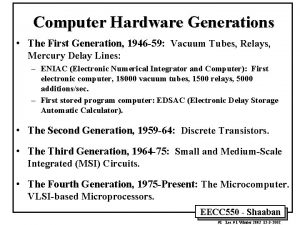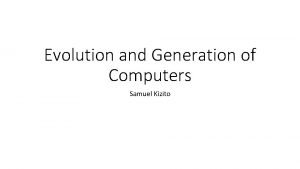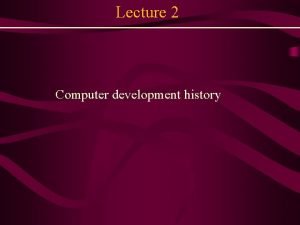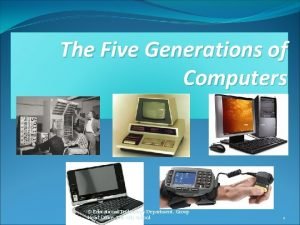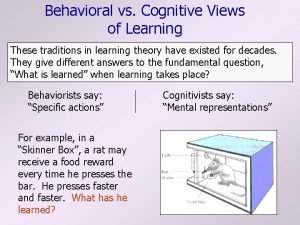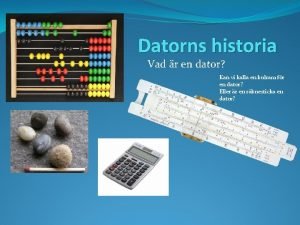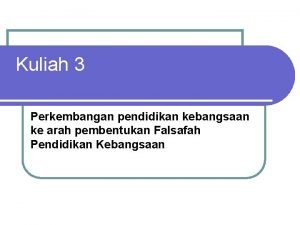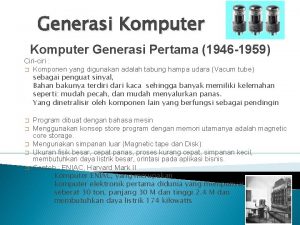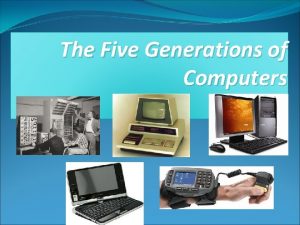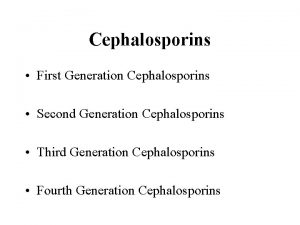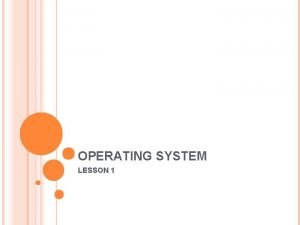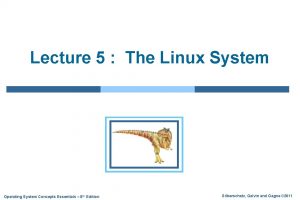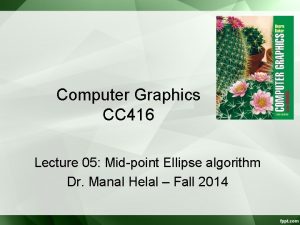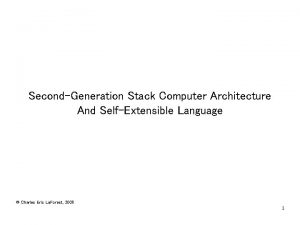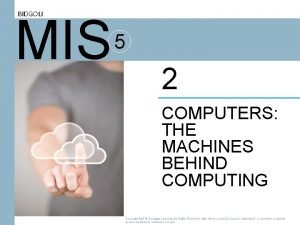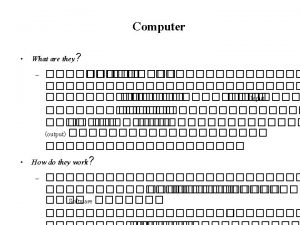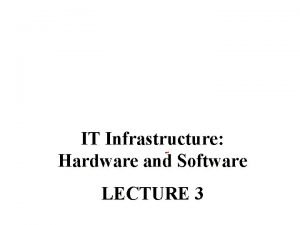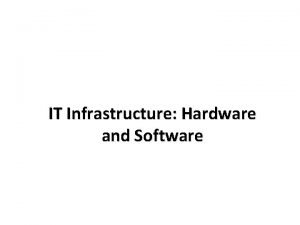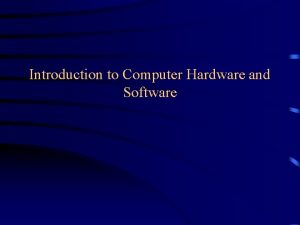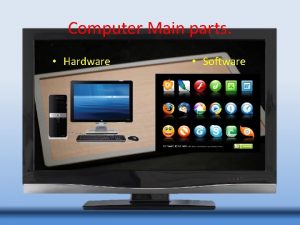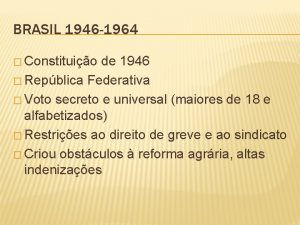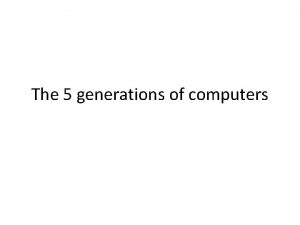Computer Hardware Generations The First Generation 1946 59















![Levels of Program Representation temp = v[k]; High Level Language Program v[k] = v[k+1]; Levels of Program Representation temp = v[k]; High Level Language Program v[k] = v[k+1];](https://slidetodoc.com/presentation_image/0db1188d6929a692ad04814809a852f4/image-16.jpg)




![RTN Statement Examples MD ¬ M[MA] – Memory locations are indicated by square brackets. RTN Statement Examples MD ¬ M[MA] – Memory locations are indicated by square brackets.](https://slidetodoc.com/presentation_image/0db1188d6929a692ad04814809a852f4/image-21.jpg)

![Instruction Set Architecture (ISA) “. . . the attributes of a [computing] system as Instruction Set Architecture (ISA) “. . . the attributes of a [computing] system as](https://slidetodoc.com/presentation_image/0db1188d6929a692ad04814809a852f4/image-23.jpg)


































- Slides: 57

Computer Hardware Generations • The First Generation, 1946 -59: Vacuum Tubes, Relays, Mercury Delay Lines: – ENIAC (Electronic Numerical Integrator and Computer): First electronic computer, 18000 vacuum tubes, 1500 relays, 5000 additions/sec. – First stored program computer: EDSAC (Electronic Delay Storage Automatic Calculator). • The Second Generation, 1959 -64: Discrete Transistors. • The Third Generation, 1964 -75: Small and Medium-Scale Integrated (MSI) Circuits. • The Fourth Generation, 1975 -Present: The Microcomputer. VLSI-based Microprocessors. EECC 550 - Shaaban #1 Lec # 1 Winter 2002 12 -3 -2002

The Von-Neumann Computer Model • Partitioning of the computing engine into components: – Central Processing Unit (CPU): Control Unit (instruction decode, sequencing of operations), Datapath (registers, arithmetic and logic unit, buses). – Memory: Instruction and operand storage. – Input/Output (I/O). – The stored program concept: Instructions from an instruction set are fetched from a common memory and executed one at a time. Control Input Memory (instructions, data) Computer System Datapath registers ALU, buses Output CPU I/O Devices EECC 550 - Shaaban #2 Lec # 1 Winter 2002 12 -3 -2002

CPU Machine Instruction Execution Steps Instruction Fetch Instruction Decode Operand Fetch Execute Result Store Next Instruction Obtain instruction from program storage Determine required actions and instruction size Locate and obtain operand data Compute result value or status Deposit results in storage for later use Determine successor or next instruction EECC 550 - Shaaban #3 Lec # 1 Winter 2002 12 -3 -2002

Hardware Components of Any Computer Five classic components of all computers: 1. Control Unit; 2. Datapath; 3. Memory; 4. Input; 5. Output } Processor Computer Processor (active) Control Unit Datapath Memory (passive) (where programs, data live when running) Devices Keyboard, Mouse, etc. Input Disk Output Display, Printer, etc. EECC 550 - Shaaban #4 Lec # 1 Winter 2002 12 -3 -2002

CPU Organization • Datapath Design: – Capabilities & performance characteristics of principal Functional Units (FUs): – (e. g. , Registers, ALU, Shifters, Logic Units, . . . ) – Ways in which these components are interconnected (buses connections, multiplexors, etc. ). – How information flows between components. • Control Unit Design: – Logic and means by which such information flow is controlled. – Control and coordination of FUs operation to realize the targeted Instruction Set Architecture to be implemented (can either be implemented using a finite state machine or a microprogram). • Hardware description with a suitable language, possibly using Register Transfer Notation (RTN). EECC 550 - Shaaban #5 Lec # 1 Winter 2002 12 -3 -2002

A Typical Microprocessor Layout: The Intel Pentium Classic EECC 550 - Shaaban #6 Lec # 1 Winter 2002 12 -3 -2002

A Typical Microprocessor Layout: The Intel Pentium Classic EECC 550 - Shaaban #7 Lec # 1 Winter 2002 12 -3 -2002

I/O I/O: Misc Memory CPU A Typical Personal Computer (PC) System Board Layout (90% of all computing systems worldwide). I/O: Mass Storage EECC 550 - Shaaban #8 Lec # 1 Winter 2002 12 -3 -2002

Computer System Components Proc Caches System Bus Memory adapters Controllers I/O Devices: Disks Displays Keyboards I/O Buses NICs Networks EECC 550 - Shaaban #9 Lec # 1 Winter 2002 12 -3 -2002

Performance Increase of Workstation-Class Microprocessors 1987 -1997 Integer SPEC 92 Performance EECC 550 - Shaaban #10 Lec # 1 Winter 2002 12 -3 -2002

Microprocessor Logic Density Moore’s Law Alpha 21264: 15 million Pentium Pro: 5. 5 million Power. PC 620: 6. 9 million Alpha 21164: 9. 3 million Sparc Ultra: 5. 2 million Moore’s Law: 2 X transistors/Chip Every 1. 5 years EECC 550 - Shaaban #11 Lec # 1 Winter 2002 12 -3 -2002

Increase of Capacity of VLSI Dynamic RAM Chips year size(Megabit) 1980 1983 1986 1989 1992 1996 1999 2000 0. 0625 0. 25 1 4 16 64 256 1024 1. 55 X/yr, or doubling every 1. 6 years EECC 550 - Shaaban #12 Lec # 1 Winter 2002 12 -3 -2002

Computer Technology Trends: • Processor: Rapid Change – 2 X in speed every 1. 5 years; 1000 X performance in last decade. • Memory: – DRAM capacity: > 2 x every 1. 5 years; 1000 X size in last decade. – Cost per bit: Improves about 25% per year. • Disk: – Capacity: > 2 X in size every 1. 5 years. – Cost per bit: Improves about 60% per year. – 200 X size in last decade. • Expected State-of-the-art PC by end of year 2002 : – Processor clock speed: – Memory capacity: – Disk capacity: > 3000 Mega. Hertz (3 Giga. Hertz) > 1000 Mega. Byte (1 Giga. Bytes) > 100 Giga. Bytes (0. 1 Tera. Bytes) EECC 550 - Shaaban #13 Lec # 1 Winter 2002 12 -3 -2002

A Simplified View of The Software/Hardware Hierarchical Layers EECC 550 - Shaaban #14 Lec # 1 Winter 2002 12 -3 -2002

Hierarchy of Computer Architecture High-Level Language Programs Software Application Operating System Machine Language Program Software/Hardware Boundary Assembly Language Programs Compiler Firmware Instr. Set Proc. I/O system Instruction Set Architecture Datapath & Control Hardware Digital Design Circuit Design Microprogram Layout Logic Diagrams Circuit Diagrams Register Transfer Notation (RTN) EECC 550 - Shaaban #15 Lec # 1 Winter 2002 12 -3 -2002
![Levels of Program Representation temp vk High Level Language Program vk vk1 Levels of Program Representation temp = v[k]; High Level Language Program v[k] = v[k+1];](https://slidetodoc.com/presentation_image/0db1188d6929a692ad04814809a852f4/image-16.jpg)
Levels of Program Representation temp = v[k]; High Level Language Program v[k] = v[k+1]; v[k+1] = temp; Compiler lw $15, 0($2) lw $16, 4($2) sw$16, 0($2) sw$15, 4($2) Assembly Language Program Assembler Machine Language Program 0000 1010 1100 0101 1001 1111 0110 1000 1100 0101 1010 0000 0110 1000 1111 1001 1010 0000 0101 1100 1111 1000 0110 0101 1100 0000 1010 1000 0110 1001 1111 Machine Interpretation Control Signal Specification ° ° ALUOP[0: 3] <= Inst. Reg[9: 11] & MASK Register Transfer Notation (RTN) EECC 550 - Shaaban #16 Lec # 1 Winter 2002 12 -3 -2002

A Hierarchy of Computer Design Level 1 Name Modules Electronics Gates, FF’s 2 Logic 3 Organization Registers, ALU’s. . . Processors, Memories Primitives Descriptive Media Transistors, Resistors, etc. Gates, FF’s …. Logic Diagrams Registers, ALU’s … Low Level - Hardware 4 Microprogramming Assembly Language Circuit Diagrams Microinstructions Register Transfer Notation (RTN) Microprogram Firmware 5 Assembly language programming 6 Procedural Programming 7 Application OS Routines Applications Drivers. . Systems Assembly language Instructions Assembly Language Programs OS Routines High-level Language Programs Procedural Constructs Problem-Oriented Programs High Level - Software EECC 550 - Shaaban #17 Lec # 1 Winter 2002 12 -3 -2002

Hardware Description • Hardware visualization: – Block diagrams (spatial visualization): Two-dimensional representations of functional units and their interconnections. – Timing charts (temporal visualization): Waveforms where events are displayed vs. time. • Register Transfer Notation (RTN): – A way to describe microoperations capable of being performed by the data flow (data registers, data buses, functional units) at the register transfer level of design (RT). – Also describes conditional information in the system which cause operations to come about. – A “shorthand” notation for microoperations. • Hardware Description Languages: – Examples: VHDL: VHSIC (Very High Speed Integrated Circuits) Hardware Description Language, Verilog. EECC 550 - Shaaban #18 Lec # 1 Winter 2002 12 -3 -2002

Register Transfer Notation (RTN) • Dependent RTN: When RTN is used after the data flow is assumed to be frozen. No data transfer can take place over a path that does not exist. No statement implies a function the data flow hardware is incapable of performing. • Independent RTN: Describe actions on registers without regard to nonexistence of direct paths or intermediate registers. No predefined data flow. • The general format of an RTN statement: Conditional information: Action 1; Action 2 • The conditional statement is often an AND of literals (status and control signals) in the system (a p-term). The p-term is said to imply the action. • Possible actions include transfer of data to/from registers/memory data shifting, functional unit operations etc. EECC 550 - Shaaban #19 Lec # 1 Winter 2002 12 -3 -2002

RTN Statement Examples A¬B – A copy of the data in entity B (typically a register) is placed in Register A – If the destination register has fewer bits than the source, the destination accepts only the lowest-order bits. – If the destination has more bits than the source, the value of the source is sign extended to the left. CTL · T 0: A = B – The contents of B are presented to the input of combinational circuit A – This action to the right of “: ” takes place when control signal CTL is active and signal T 0 is active. EECC 550 - Shaaban #20 Lec # 1 Winter 2002 12 -3 -2002
![RTN Statement Examples MD MMA Memory locations are indicated by square brackets RTN Statement Examples MD ¬ M[MA] – Memory locations are indicated by square brackets.](https://slidetodoc.com/presentation_image/0db1188d6929a692ad04814809a852f4/image-21.jpg)
RTN Statement Examples MD ¬ M[MA] – Memory locations are indicated by square brackets. – Means the memory data register receives the contents of the main memory (M) as addressed from the Memory Address (MA) register. AC(0), AC(1), AC(2), AC(3) – – – Register fields are indicated by parenthesis. The concatenation operation is indicated by a comma. Bit AC(0) is bit 0 of the accumulator AC The above expression means AC bits 0, 1, 2, 3 More commonly represented by AC(0 -3) E · T 3: CLRWRITE – The control signal CLRWRITE is activated when the condition E · T 3 is active. EECC 550 - Shaaban #21 Lec # 1 Winter 2002 12 -3 -2002

Computer Architecture Vs. Computer Organization • The term Computer architecture is sometimes erroneously restricted to computer instruction set design, with other aspects of computer design called implementation. • More accurate definitions: – Instruction set architecture: The actual programmer-visible instruction set and serves as the boundary between the software and hardware. – Implementation of a machine has two components: • Organization: includes the high-level aspects of a computer’s design such as: The memory system, the bus structure, the internal CPU unit which includes implementations of arithmetic, logic, branching, and data transfer operations. • Hardware: Refers to the specifics of the machine such as detailed logic design and packaging technology. • In general, Computer Architecture refers to the above three aspects: 1 - Instruction set architecture 2 - Organization. 3 - Hardware. EECC 550 - Shaaban #22 Lec # 1 Winter 2002 12 -3 -2002
![Instruction Set Architecture ISA the attributes of a computing system as Instruction Set Architecture (ISA) “. . . the attributes of a [computing] system as](https://slidetodoc.com/presentation_image/0db1188d6929a692ad04814809a852f4/image-23.jpg)
Instruction Set Architecture (ISA) “. . . the attributes of a [computing] system as seen by the programmer, i. e. the conceptual structure and functional behavior, as distinct from the organization of the data flows and controls the logic design, and the physical implementation. ” – Amdahl, Blaaw, and Brooks, 1964. The instruction set architecture is concerned with: • Organization of programmable storage (memory & registers): Includes the amount of addressable memory and number of available registers. • Data Types & Data Structures: Encodings & representations. • Instruction Set: What operations are specified. • Instruction formats and encoding. • Modes of addressing and accessing data items and instructions • Exceptional conditions. EECC 550 - Shaaban #23 Lec # 1 Winter 2002 12 -3 -2002

Computer Instruction Sets • Regardless of computer type, CPU structure, or hardware organization, every machine instruction must specify the following: – Opcode: Which operation to perform. Example: add, load, and branch. – Where to find the operand or operands, if any: Operands may be contained in CPU registers, main memory, or I/O ports. – Where to put the result, if there is a result: May be explicitly mentioned or implicit in the opcode. – Where to find the next instruction: Without any explicit branches, the instruction to execute is the next instruction in the sequence or a specified address in case of jump or branch instructions. EECC 550 - Shaaban #24 Lec # 1 Winter 2002 12 -3 -2002

Instruction Set Architecture (ISA) Instruction Specification Requirements Fetch Instruction Decode Operand Fetch Execute Result Store Next Instruction • Instruction Format or Encoding: – How is it decoded? • Location of operands and result (addressing modes): – Where other than memory? – How many explicit operands? – How are memory operands located? – Which can or cannot be in memory? • Data type and Size. • Operations – What are supported • Successor instruction: – Jumps, conditions, branches. • Fetch-decode-execute is implicit. EECC 550 - Shaaban #25 Lec # 1 Winter 2002 12 -3 -2002

General Types of Instructions • Data Movement Instructions, possible variations: – – – Memory-to-memory. Memory-to-CPU register. CPU-to-memory. Constant-to-CPU register. CPU-to-output. etc. • Arithmetic Logic Unit (ALU) Instructions. • Branch Instructions: – Unconditional. – Conditional. EECC 550 - Shaaban #26 Lec # 1 Winter 2002 12 -3 -2002

Examples of Data Movement Instructions Instruction Meaning Machine MOV A, B Move 16 -bit data from memory loc. A to loc. B VAX 11 lwz R 3, A Move 32 -bit data from memory loc. A to register R 3 PPC 601 li $3, 455 Load the 32 -bit integer 455 into register $3 MIPS R 3000 MOV AX, BX Move 16 -bit data from register BX into register AX Intel X 86 LEA. L (A 0), A 2 Load the address pointed to by A 0 into A 2 MC 68000 EECC 550 - Shaaban #27 Lec # 1 Winter 2002 12 -3 -2002

Examples of ALU Instructions Instruction Meaning Machine MULF A, B, C Multiply the 32 -bit floating point values at mem. locations A and B, and store result in loc. C VAX 11 nabs r 3, r 1 Store the negative absolute value of register r 1 in r 2 PPC 601 ori $2, $1, 255 Store the logical OR of register $1 with 255 into $2 MIPS R 3000 SHL AX, 4 Shift the 16 -bit value in register AX left by 4 bits Intel X 86 ADD. L D 0, D 1 Add the 32 -bit values in registers D 0, D 1 and store the result in register D 0 MC 68000 EECC 550 - Shaaban #28 Lec # 1 Winter 2002 12 -3 -2002

Examples of Branch Instructions Instruction Meaning Machine BLBS A, Tgt Branch to address Tgt if the least significant bit at location A is set. VAX 11 bun r 2 Branch to location in r 2 if the previous comparison signaled that one or more values was not a number. PPC 601 Beq $2, $1, 32 Branch to location PC+4+32 if contents of $1 and $2 are equal. MIPS R 3000 JCXZ Addr Jump to Addr if contents of register CX = 0. Intel X 86 BVS next Branch to next if overflow flag in CC is set. MC 68000 EECC 550 - Shaaban #29 Lec # 1 Winter 2002 12 -3 -2002

Operation Types in The Instruction Set Operator Type Examples Arithmetic and logical Integer arithmetic and logical operations: add, or Data transfer Loads-stores (move on machines with memory addressing) Control Branch, jump, procedure call, and return, traps. System Operating system call, virtual memory management instructions Floating point operations: add, multiply. Decimal add, decimal multiply, decimal to character conversion String move, string compare, string search Graphics Pixel operations, compression/ decompression operations EECC 550 - Shaaban #30 Lec # 1 Winter 2002 12 -3 -2002

Instruction Usage Example: Top 10 Intel X 86 Instructions Rank instruction Integer Average Percent total executed 1 load 22% 2 conditional branch 20% 3 compare 16% 4 store 12% 5 add 8% 6 and 6% 7 sub 5% 8 move register-register 4% 9 call 1% 10 return 1% Total 96% Observation: Simple instructions dominate instruction usage frequency. EECC 550 - Shaaban #31 Lec # 1 Winter 2002 12 -3 -2002

Types of Instruction Set Architectures According To Operand Addressing Fields Memory-To-Memory Machines: – Operands obtained from memory and results stored back in memory by any instruction that requires operands. – No local CPU registers are used in the CPU datapath. – Include: • The 4 Address Machine. • The 3 -address Machine. • The 2 -address Machine. The 1 -address (Accumulator) Machine: – A single local CPU special-purpose register (accumulator) is used as the source of one operand as the result destination. The 0 -address or Stack Machine: – A push-down stack is used in the CPU. General Purpose Register (GPR) Machines: – The CPU datapath contains several local general-purpose registers which can be used as operand sources and as result destinations. – A large number of possible addressing modes. – Load-Store or Register-To-Register Machines: GPR machines where only data movement instructions (loads, stores) can obtain operands from memory and store results to memory. EECC 550 - Shaaban #32 Lec # 1 Winter 2002 12 -3 -2002

Types of Instruction Set Architectures Memory-To-Memory Machines: The 4 -Address Machine • • No program counter (PC) or other CPU registers are used. Instructions specify: – Location of first operand. - Location of second operand. – Place to store the result. - Location of next instruction. Memory CPU Instruction: Op 1 Addr: Op 1 Op 2 Addr: Op 2 add Res, Op 1, Op 2, Nexti + Meaning: (Res ¬ Op 1 + Op 2) Res. Addr: Res : : Instruction Format Bits: Nexti. Addr: Nexti 8 24 add Res. Addr Opcode Which operation Where to put result 24 24 Op 1 Addr Op 2 Addr Where to find operands 24 Nexti. Addr Where to find next instruction EECC 550 - Shaaban #33 Lec # 1 Winter 2002 12 -3 -2002

Types of Instruction Set Architectures Memory-To-Memory Machines: The 3 -Address Machine • • A program counter is included within the CPU which points to the next instruction. No CPU storage (general-purpose registers). Memory CPU Instruction: Op 1 Addr: Op 1 Op 2 Addr: Op 2 add Res, Op 1, Op 2 + Meaning: Res. Addr: Res : : Nexti. Addr: Nexti (Res ¬ Op 1 + Op 2) Where to find next instruction Program 24 Counter (PC) Instruction Format Bits: 8 24 add Res. Addr Opcode Which operation 24 Where to put result Op 1 Addr 24 Op 2 Addr Where to find operands EECC 550 - Shaaban #34 Lec # 1 Winter 2002 12 -3 -2002

Types of Instruction Set Architectures Memory-To-Memory Machines: The 2 -Address Machine • The 2 -address Machine: Result is stored in the memory address of one of the operands. Memory CPU Instruction: add Op 2, Op 1 Addr: Op 1 + Meaning: (Op 2 ¬ Op 1 + Op 2) Op 2 Addr: Op 2, Res : : Nexti. Addr: Nexti Instruction Format Where to find next instruction Program 24 Counter (PC) Bits: 8 24 add Op 2 Addr Opcode Which operation 24 Op 1 Addr Where to find operands Where to put result EECC 550 - Shaaban #35 Lec # 1 Winter 2002 12 -3 -2002

Types of Instruction Set Architectures The 1 -address (Accumulator) Machine • A single accumulator in the CPU is used as the source of one operand result destination. Memory CPU Instruction: Op 1 Addr: Op 1 add Op 1 + : : Nexti. Addr: Nexti Where to find operand 2, and where to put result Meaning: (Acc ¬ Acc + Op 1) Accumulator Where to find next instruction Program 24 Counter (PC) Instruction Format Bits: 8 24 add Op 1 Addr Opcode Where to find Which operand 1 operation EECC 550 - Shaaban #36 Lec # 1 Winter 2002 12 -3 -2002

Types of Instruction Set Architectures The 0 -address (Stack) Machine • A push-down stack is used in the CPU Memory push Op 1 Addr: Op 1 Op 2 Addr: Op 2 Res. Addr: Res : : Nexti. Addr: Nexti Stack pop TOS Op 2, Res SOS Op 1 add + etc. 8 Program 24 Counter (PC) Instruction Format Instruction: 24 Bits: 8 push Op 1 Meaning: push Op 1 Addr (TOS ¬ Op 1) Opcode Where to find operand Instruction: Instruction Format add Bits: 8 Meaning: add (TOS ¬ TOS + SOS) Opcode Instruction Format Instruction: 24 Bits: 8 pop Res. Addr Meaning: (Res ¬ TOS) Opcode Memory Destination EECC 550 - Shaaban #37 Lec # 1 Winter 2002 12 -3 -2002

Types of Instruction Set Architectures General Purpose Register (GPR) Machines • CPU contains several general-purpose registers which can be used as operand sources and result destination. CPU Memory Op 1 Addr: Op 1 add : : Nexti. Addr: Nexti Registers load R 8 + R 7 R 6 R 5 R 4 R 3 store R 2 R 1 Program 24 Counter (PC) Instruction: load R 8, Op 1 Meaning: (R 8 ¬ Op 1) Instruction Format Bits: 8 load 24 R 8 Op 1 Addr Opcode Instruction: add R 2, R 4, R 6 Meaning: (R 2 ¬ R 4 + R 6) Instruction: store R 2, Op 2 Meaning: (Op 2 ¬ R 2) 3 Where to find operand 1 Instruction Format 3 3 3 Bits: 8 add R 2 R 4 R 6 Opcode Des Operands Instruction Format Bits: 8 store Opcode 3 24 R 2 Res. Addr Destination EECC 550 - Shaaban #38 Lec # 1 Winter 2002 12 -3 -2002

Expression Evaluation Example with 3 -, 2 -, 1 -, 0 -Address, And GPR Machines For the expression A = (B + C) * D - E 3 -Address 2 -Address add A, B, C load A, B mul A, A, D add A, C sub A, A, E mul A, D sub A, E 3 instructions Code size: 30 bytes 9 memory accesses 1 -Address Accumulator load B add C mul D sub E store A 4 instructions 5 instructions Code size: 28 bytes 12 memory accesses 20 bytes 5 memory accesses where A-E are in memory GPR 0 -Address Load-Store Register-Memory Stack push B push C add push D mul push E sub pop A 8 instructions Code size: 23 bytes 5 memory accesses load R 1, B add R 1, C mul R 1, D sub R 1, E store A, R 1 5 instructions Code size: about 22 bytes 5 memory accesses load R 1, B load R 2, C add R 3, R 1, R 2 load R 1, D mul R 3, R 1 load R 1, E sub R 3, R 1 store A, R 3 8 instructions Code size: about 29 bytes 5 memory accesses EECC 550 - Shaaban #39 Lec # 1 Winter 2002 12 -3 -2002

Typical ISA Addressing Modes Addressing Mode Sample Instruction Meaning Register Add R 4, R 3 R 4 ¬ R 4 + R 3 Immediate Add R 4, #3 R 4 ¬ R 4 + 3 Displacement Add R 4, 10 (R 1) R 4 ¬ R 4 + Mem[10+ R 1] Indirect Add R 4, (R 1) R 4 ¬ R 4 + Mem[R 1] Indexed Add R 3, (R 1 + R 2) R 3 ¬ R 3 +Mem[R 1 + R 2] Absolute Add R 1, (1001) R 1 ¬ R 1 + Mem[1001] Memory indirect Add R 1, @ (R 3) R 1 ¬ R 1 + Mem[R 3]] Autoincrement Add R 1, (R 2) + R 1 ¬ R 1 + Mem[R 2] R 2 ¬ R 2 + d Autodecrement Add R 1, - (R 2) R 2 ¬ R 2 - d R 1 ¬ R 1 + Mem[R 2] Scaled Add R 1, 100 (R 2) [R 3] R 1 ¬ R 1+ Mem[100+ R 2 + R 3*d] EECC 550 - Shaaban #40 Lec # 1 Winter 2002 12 -3 -2002

Addressing Modes Usage Example For 3 programs running on VAX ignoring direct register mode: Displacement 42% avg, 32% to 55% Immediate: 33% avg, 17% to 43% Register deferred (indirect): 13% avg, 3% to 24% Scaled: 7% avg, 0% to 16% Memory indirect: 3% avg, 1% to 6% Misc: 2% avg, 0% to 3% 75% 88% 75% displacement & immediate 88% displacement, immediate & register indirect. Observation: In addition Register direct, Displacement, Immediate, Register Indirect addressing modes are important. EECC 550 - Shaaban #41 Lec # 1 Winter 2002 12 -3 -2002

Displacement Address Size Example Avg. of 5 SPECint 92 programs v. avg. 5 SPECfp 92 programs Displacement Address Bits Needed 1% of addresses > 16 -bits 12 - 16 bits of displacement needed EECC 550 - Shaaban #42 Lec # 1 Winter 2002 12 -3 -2002

Instruction Set Encoding Considerations affecting instruction set encoding: – To have as many registers and addressing modes as possible. – The Impact of of the size of the register and addressing mode fields on the average instruction size and on the average program. – To encode instructions into lengths that will be easy to handle in the implementation. On a minimum to be a multiple of bytes. • Fixed length encoding: Faster and easiest to implement in hardware. • Variable length encoding: Produces smaller instructions. • Hybrid encoding. EECC 550 - Shaaban #43 Lec # 1 Winter 2002 12 -3 -2002

Three Examples of Instruction Set Encoding Operations & no of operands Address specifier 1 Address field 1 Address specifier n Address field n Variable Length Encoding: VAX (1 -53 bytes) Operation Address field 1 Address field 2 Fixed Length Encoding: Operation Address Specifier 1 Address Specifier Address field 3 DLX, MIPS, Power. PC, SPARC Address field Address Specifier 2 Address field 1 Address field 2 Hybrid Encoding: IBM 360/370, Intel 80 x 86 EECC 550 - Shaaban #44 Lec # 1 Winter 2002 12 -3 -2002

Instruction Set Architecture Trade-offs • 3 -address machine: shortest code sequence; a large number of bits per instruction; large number of memory accesses. • 0 -address (stack) machine: Longest code sequence; shortest individual instructions; more complex to program. • General purpose register machine (GPR): – Addressing modified by specifying among a small set of registers with using a short register address (all machines since 1975). – Advantages of GPR: • Low number of memory accesses. Faster, since register access is currently still much faster than memory access. • Registers are easier for compilers to use. • Shorter, simpler instructions. • Load-Store Machines: GPR machines where memory addresses are only included in data movement instructions between memory and registers (all machines after 1980). EECC 550 - Shaaban #45 Lec # 1 Winter 2002 12 -3 -2002

ISA Examples Machine Number of General Purpose Registers Architecture year EDSAC 1 accumulator 1949 IBM 701 1 accumulator 1953 CDC 6600 8 load-store 1963 IBM 360 16 register-memory 1964 DEC PDP-11 8 register-memory 1970 DEC VAX 16 register-memory-memory 1977 Motorola 68000 16 register-memory 1980 MIPS 32 load-store 1985 SPARC 32 load-store 1987 EECC 550 - Shaaban #46 Lec # 1 Winter 2002 12 -3 -2002

Examples of GPR Machines Number of memory addresses Maximum number of operands allowed 0 3 SPARK, MIPS Power. PC, ALPHA 1 2 Intel 80 x 86, Motorola 68000 2 or 3 VAX EECC 550 - Shaaban #47 Lec # 1 Winter 2002 12 -3 -2002

Complex Instruction Set Computer (CISC) • Emphasizes doing more with each instruction. • Motivated by the high cost of memory and hard disk capacity when original CISC architectures were proposed: – When M 6800 was introduced: 16 K RAM = $500, 40 M hard disk = $ 55, 000 – When MC 68000 was introduced: 64 K RAM = $200, 10 M HD = $5, 000 • Original CISC architectures evolved with faster, more complex CPU designs, but backward instruction set compatibility had to be maintained. • Wide variety of addressing modes: • 14 in MC 68000, 25 in MC 68020 • A number instruction modes for the location and number of operands: • The VAX has 0 - through 3 -address instructions. • Variable-length or hybrid instruction encoding is used. EECC 550 - Shaaban #48 Lec # 1 Winter 2002 12 -3 -2002

Example CISC ISAs Motorola 680 X 0 18 addressing modes: • • • • • Data register direct. Address register direct. Immediate. Absolute short. Absolute long. Address register indirect with postincrement. Address register indirect with predecrement. Address register indirect with displacement. Address register indirect with index (8 -bit). Address register indirect with index (base). Memory inderect postindexed. Memory indirect preindexed. Program counter indirect with index (8 -bit). Program counter indirect with index (base). Program counter indirect with displacement. Program counter memory indirect postindexed. Program counter memory indirect preindexed. Operand size: • Range from 1 to 32 bits, 1, 2, 4, 8, 10, or 16 bytes. Instruction Encoding: • Instructions are stored in 16 -bit words. • the smallest instruction is 2 - bytes (one word). • The longest instruction is 5 words (10 bytes) in length. EECC 550 - Shaaban #49 Lec # 1 Winter 2002 12 -3 -2002

Example CISC ISA: Intel X 86, 386/486/Pentium 12 addressing modes: • • • Register. Immediate. Direct. Base + Displacement. Index + Displacement. Scaled Index + Displacement. Based Index. Based Scaled Index. Based Index + Displacement. Based Scaled Index + Displacement. Relative. Operand sizes: • Can be 8, 16, 32, 48, 64, or 80 bits long. • Also supports string operations. Instruction Encoding: • The smallest instruction is one byte. • The longest instruction is 12 bytes long. • The first bytes generally contain the opcode, mode specifiers, and register fields. • The remainder bytes are for address displacement and immediate data. EECC 550 - Shaaban #50 Lec # 1 Winter 2002 12 -3 -2002

Reduced Instruction Set Computer (RISC) • Focuses on reducing the number and complexity of instructions of the machine. • Reduced number of cycles needed per instruction. – Goal: At least one instruction completed per clock cycle. • • Designed with CPU instruction pipelining in mind. Fixed-length instruction encoding. Only load and store instructions access memory. Simplified addressing modes. – Usually limited to immediate, register indirect, register displacement, indexed. • Delayed loads and branches. • Prefetch and speculative execution. • Examples: MIPS, HP-PA, Ultra. Spark, Alpha, Power. PC. EECC 550 - Shaaban #51 Lec # 1 Winter 2002 12 -3 -2002

Example RISC ISA: Power. PC 8 addressing modes: • • Register direct. Immediate. Register indirect with immediate index (loads and stores). Register indirect with register index (loads and stores). Absolute (jumps). Link register indirect (calls). Count register indirect (branches). Operand sizes: • Four operand sizes: 1, 2, 4 or 8 bytes. Instruction Encoding: • Instruction set has 15 different formats with many minor variations. • • All are 32 bits in length. EECC 550 - Shaaban #52 Lec # 1 Winter 2002 12 -3 -2002

Example RISC ISA: HP Precision Architecture, HP-PA 7 addressing modes: • • Register Immediate Base with displacement Base with scaled index and displacement Predecrement Postincrement PC-relative Operand sizes: • Five operand sizes ranging in powers of two from 1 to 16 bytes. Instruction Encoding: • Instruction set has 12 different formats. • • All are 32 bits in length. EECC 550 - Shaaban #53 Lec # 1 Winter 2002 12 -3 -2002

Example RISC ISA: SPARC 5 addressing modes: • • • Register indirect with immediate displacement. Register inderect indexed by another register. Register direct. Immediate. PC relative. Operand sizes: • Four operand sizes: 1, 2, 4 or 8 bytes. Instruction Encoding: • Instruction set has 3 basic instruction formats with 3 minor variations. • All are 32 bits in length. EECC 550 - Shaaban #54 Lec # 1 Winter 2002 12 -3 -2002

Example RISC ISA: DEC/Compaq Alpha AXP 4 addressing modes: • • Register direct. Immediate. Register indirect with displacement. PC-relative. Operand sizes: • Four operand sizes: 1, 2, 4 or 8 bytes. Instruction Encoding: • Instruction set has 7 different formats. • • All are 32 bits in length. EECC 550 - Shaaban #55 Lec # 1 Winter 2002 12 -3 -2002

RISC ISA Example: MIPS R 3000 4 Addressing Modes: Instruction Categories: • • Load/Store. Computational. Jump and Branch. Floating Point (using coprocessor). Memory Management. Special. • • • Base register + immediate offset (loads and stores). Register direct (arithmetic). Immedate (jumps). PC relative (branches). Registers R 0 - R 31 Operand Sizes: • PC HI Memory accesses in any multiple between 1 and 8 bytes. LO Instruction Encoding: 3 Instruction Formats, all 32 bits wide. OP rs rt OP rd sa funct immediate jump target EECC 550 - Shaaban #56 Lec # 1 Winter 2002 12 -3 -2002

Evolution of Instruction Set Architectures Single Accumulator (EDSAC 1950) Accumulator + Index Registers (Manchester Mark I, IBM 700 series 1953) Separation of Programming Model from Implementation High-level Language Based (B 5000 1963) Concept of an ISA Family (IBM 360 1964) General Purpose Register (GPR) Machines Complex Instruction Sets (CISC) (Vax, Motorola 68000, Intel x 86 1977 -80) Load/Store Architecture (CDC 6600, Cray 1 1963 -76) RISC (MIPS, SPARC, HP-PA, IBM RS 6000, . . . 1987) EECC 550 - Shaaban #57 Lec # 1 Winter 2002 12 -3 -2002
 Computer hardware generation
Computer hardware generation 4th generation of computer images
4th generation of computer images First generation antipsychotics
First generation antipsychotics What type of computer is this
What type of computer is this First generation of computer
First generation of computer Basic concepts of computer science
Basic concepts of computer science What are five generation of computer
What are five generation of computer You are good and your mercy endureth forever
You are good and your mercy endureth forever Hardware internal and external
Hardware internal and external Hungary inflation rate 1946
Hungary inflation rate 1946 Fati timp
Fati timp Hungary inflation rate 1946
Hungary inflation rate 1946 Dasar cheeseman
Dasar cheeseman Pekeliling no 9 1946
Pekeliling no 9 1946 Lbb 1950/10
Lbb 1950/10 David alfaro siqueiros nueva resurrección
David alfaro siqueiros nueva resurrección Tolman ritchie and kalish (1946)
Tolman ritchie and kalish (1946) 1946 römische zahlen
1946 römische zahlen The iron curtain cartoon meaning
The iron curtain cartoon meaning Datorns historia
Datorns historia Carta da paz social 1946
Carta da paz social 1946 1980-1946
1980-1946 Kurikulum 1946, kurikulum 1957, dan kurikulum 1961
Kurikulum 1946, kurikulum 1957, dan kurikulum 1961 Iso 1946
Iso 1946 Inférence définition
Inférence définition 1946 born
1946 born Pendidikan era kemerdekaan menitikberatkan
Pendidikan era kemerdekaan menitikberatkan Komputer generasi pertama muncul tahun 1946 dengan nama
Komputer generasi pertama muncul tahun 1946 dengan nama First generation consoles
First generation consoles 1st generation rights
1st generation rights Generation of computer 1st to 5th
Generation of computer 1st to 5th Examples of right
Examples of right Synthesis of cephalosporin slideshare
Synthesis of cephalosporin slideshare Glibenclamide class
Glibenclamide class Inherent human rights
Inherent human rights Cephalosporin third generation
Cephalosporin third generation First generation cephalosporin
First generation cephalosporin First generation cephalosporin
First generation cephalosporin Financial aid algonquin
Financial aid algonquin First generation of operating system
First generation of operating system Pedigrees practice
Pedigrees practice First generation jails
First generation jails 1st generation fluoroquinolones
1st generation fluoroquinolones The first linux kernel which supports the smp hardware
The first linux kernel which supports the smp hardware Process of management by objectives
Process of management by objectives Advantages and disadvantages of boundary fill algorithm
Advantages and disadvantages of boundary fill algorithm Transistors were used in which generation of computers
Transistors were used in which generation of computers 5 generation of computer
5 generation of computer Midpoint of ellipse
Midpoint of ellipse Size of second generation computer
Size of second generation computer What is stack in computer architecture
What is stack in computer architecture Second generation of computer
Second generation of computer Application
Application Language tool
Language tool Software and its types
Software and its types Computer hardware platforms in it infrastructure
Computer hardware platforms in it infrastructure Hardware computer definition
Hardware computer definition Computer arithmetic: algorithms and hardware designs
Computer arithmetic: algorithms and hardware designs
